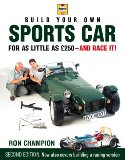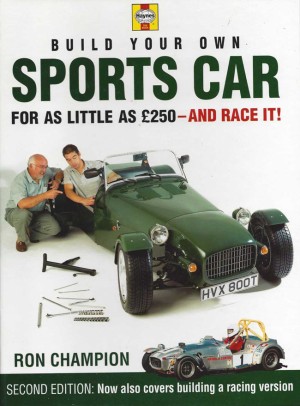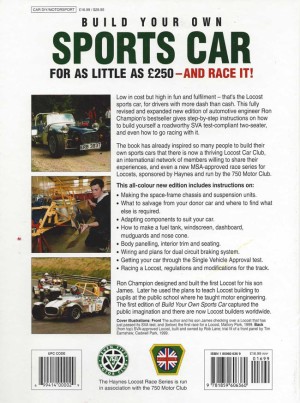Build Your Own Sports Car for as Little as £250 and Race It!

 (5/5) by
(5/5) by - All
- Dynamics/Handling ( Basic)
- Chassis ( Basic)
- Suspension ( Basic)
- Powertrain ( Basic)
- Safety/Ergo/Interior ( Basic)
- Materials/Fabrication ( Basic)
- Materials/Fabrication ( Advanced)
- Fasteners/Joining ( Basic)
- Fasteners/Joining ( Advanced)
- Construction/Assy ( Basic)
- Construction/Assy ( Advanced)
- Electrical ( Basic)
- Bodywork ( Basic)
Overview
Whether you are designing a race car from scratch, looking to build from plans or simply trying to understand what it takes to build your own race car, Ron Champion’s book is a wonderful resource to have. While the book focuses on building a specific type of road car (A Lotus 7 replica, these days referred to as a "Lowcost"), it offers many insights into the components, design and fabrication of a race car.
Review
By Matt Gartner
There is a special genre of race car design books that give amateur designers a "Big picture" view of a vehicle project. I like to call them "Whole car" books because they usually cover all aspects of a car's fabrication and assembly. They are not design books which teach how to design from a blank page, but rather build books that walk you through a plan and how to put together the pieces.
"Build Your Own Sports Car For As Little As £250" is the best example of this genre.
The goal of the book is to help someone construct their own Lotus 7 replica car ("Lowcost"). For that purpose, the book has been a great success as witnessed by the many Lowcost cars in the world. I would say doing it for £250 is dreaming, but by salvaging/being frugal you could build one for some pretty small change. If you are interested in building your own Lowcost, then this book is for you—no doubt about that.
However, if we look past the Lotus 7 replica car-specifics, this book is also a guide to the construction and assembly of one complete example of a race car or vehicle. I believe this is where this book shines for the person doing their own design--the insights you can glean by studying the diagrams, drawings, parts, lists and procedures.
For instance, I could apply the information provided on the spaceframe to give me some points of reference in designing my own spaceframe. I can use the book's donor vehicle parts as a reference point in selecting my own comparable parts from a different car. The lists of parts can act as checklists for sourcing. And so on.

The book is laid out in a logical progression. It begins with history, tools/skills, and part sourcing as its first chapters. Upon this foundation, the author goes into detail on building the spaceframe chassis, and proceeds in successive chapter to look at the components which mount to the chassis.
Final assembly and finishing round out the book's contents. One area the author also looks at is road certification in the UK. While not 100% applicable elsewhere, similar laws for home builts do exist elsewhere so the tenets discussed can be useful especially to those designing road-going machines.
Along with its instructive text, the book provides a vast number of color photographs and plan diagrams with dimensions.
Book Sections
Tools/Skills Required
This section provides an overview of the skills and tools needed to construct the car. For anyone considering building a car, this is very helpful. Of course, you may find more comprehensive toolsets in specialized fabrication books (ie. composite or metal fabrication), but for the purposes of building a car it is a good place to start.
The author provides a nice introduction to the skills required. Reading it provides an appreciation of the efforts and talents that go into building a car. In terms of tools, he discusses the hand tools, power tools and standalone machines that are required and/or useful.
Parts and Materials
The book assumes the donor car for the parts to be a British Ford Escort (Mk. I or Mk. II). If you don't live in the UK (where even this car is now very rare in junkyards), you will need to find an alternate donor car which uses rear-wheel drive (The Mazda Miata is touted as a good choice by the book "How to Build a Cheap Sports Car" by Keith Tanner, which is considered a companion to this book.).
For those using the book as a recipe for building their own car, the donor parts list and diagrams are perfect for helping define the attributes your own design will need to take into account.
Materials discussed include metal tubing, bar and sheet sizes required.
Making the Spaceframe Chassis
Building the chassis is the second largest chapter (27 pages) of the book. It shows numerous diagrams of the chassis design with dimensions, as well as tube lengths. Alongside the diagrams and photographs that document the fabrication of the chassis is the procedure text itself. This is divided into phases of construction starting as you would expect from the bottom of the frame and working up.
For someone building their own design, the chassis design of the Lowcost, having been proven out by the numerous cars in existence, can also provide a good study of how certain areas of the spaceframe are designed to deal with loads. Even without access to FEA software, a person can use balsa and their observations of a well designed frame to "guestimate" their own needs.
Bracketing and other "attachments" points welded to the chassis are also diagrammed, and these again can be taken as-is or used as a starting point for your own design.
Steering Rack/Rear Axle Modifications
The steering rack section gives a brief pictorial overview of the mounting of the steering rack, but without any major detail or instructions.
The rear axle modifications section provides patterns and diagrams of brackets and linkages with which to mount and suspend the rear axle. Coilover springs are included in the design.
Front Suspension/Rear Suspension
One of my favourite sections of this book was the front suspension. The diagrams in this section are excellent at showing the elements of the suspension—hub, upright, mounting points. Front wishbone plans and fabrication jig plans are included as well. Trailing arm plans for the rear axle and a Panhard rod plan are also shown.
For someone designing their own homemade suspension, this section, even though written for the Lowcost, still provides good insights on how you can fabricate your own design.

Exhaust
The exhaust system on the Lowcost car runs out of and along the sides, and so this section gives some brief visuals and descriptions on mounting a stock exhaust manifold and using a heat-shield to protect people from the muffler heat.

Fuel Tank
This section provides plans and photos the Lowcost fuel tank. The tank is a sheet metal fabrication exercise, so plans are provided for panels and folds. In addition, fabrication instructions detail the build process.
Nose and fenders
Only a very brief treatment is given to the nose and fenders of the Lowcost design. The author recommends builders purchase the nose and fenders from a Lowcost parts manufacturer, of which I believe there are some in the UK. I guess this makes sense in the context of the book—It appears the author only intended the Lowcost design to require minimal fabrication.
Body Panels
This section covers the home fabrication and bending of the needed metal panels. Plans showing the panel shapes and cutouts for suspension components are also included.
There are numerous photos which show the panels and their attachment to the chassis, making fabrication and assembly clearer.
Final Assembly
This section is composed of assembling the components, plumbing, electrical, dashboard and interior. It leads off with assembly of the steering rack, powertrain, suspension components, exhaust, radiator and body panels.
Then, the fuel tank is installed and plumbed. There is a handy diagram showing the brake lines/master cylinder plumbing which needs to be performed.
The book shows how to fabricate the dashboard backing, and then proceeds into the electrical system. The wiring loom of the donor car is used and modified to enable the attachment of lights and electrical controls.
Fabrication directions are also given for a windscreen and for upholstering the seats in the car.
Racing the Car
The second edition of this book (published in 2000) contains an additional section for modifications to the Lowcost for racing. The modifications discussed include adding a rollbar, racing harnesses, racing fuel tank filler/vent/cap, oil catch, racing tires and other component upgrades for racing.
Appendices
The appendices include a photo gallery of finished Lowcost cars and recommended reading.
Helpfulness to amateur race car designers
Aside from guiding a person in building a Lowcost race car, this book is useful in bringing together the big picture of component interconnections and of practices used by designers/builders on this tried and true design. The insights into spaceframe design and fabrication, custom built wishbones, and donor components and their placement are of practical value to any first time builder.
28





